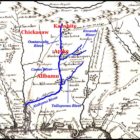Abikudshi
Abikudshi
Abikudshi (‘Little Abihka’). A former Upper Creek town in North Talladega County, Alabama, on the right bank of Tallahatchee Creek, 5 miles east of Coosa River. It was settled by Abihka Indians and some of the Natchez. Bartram (1775) states that the inhabitants spoke a dialect of Chickasaw, which could have been true of only a part.
At a very early date, however, a large body of Natchez passed over from the Chickasaw to the Creeks. In fact this was probably the largest section of the nation. Their settlement among the Creeks antedated 1744, for Adair, in enumerating the Creek towns, says: “With them also is one town of the Sha-wa-no, and one of the Nahchee Indians; “” and further on he mentions “Ooe-Asah, the upper western town of the Muskohgeh, settled by the Chickasaw and Nahchee.” 6 “Ooe-Asah ” was probably more Chickasaw than Natchez, but the largest number of the Natchez immigrants into Creek territory ultimately formed a town of their own bearing their name on Tallahatchee creek, formerly called Natche creek, 10 miles above its junction with Coosa river, in the southeastern part of Talladega county, Ala. (pi. 6, b). They also formed a part of the population of Abikudshi, 5 miles below. Bouquet’s estimate of 17(,4 gives the number of their warriors as 150.'” Swan, who visited the Creeks in 1791, speaks of the Natchez as occupying more villages than one, and says of them: “The Natchez, or Sunset Indians, from the Mississippi, joined the Creeks about fifty years since, after being driven out from Louisiana, and added considerably to the confederative body.” He mentions their chief, Dog Warrior, as one of the most prominent in the confederacy.*
Hawkins, in his Sketch of the Creek Country in the Years 1798 and 1799, speaks of the Natchez town as follows:
Nau-chee, on Nauehee creek, 5 miles above Au-be-coo-che, below the fork of the creek, on a rich flat of land of a mile in width, between two small mountains. This flat extends from the town three-quarters of a mile above the town nouse. The settlements are scattered on both sides of the creek for 2 miles; they have no worm fences, and but little stock. One chief, a brother of China-be. has a large stock of hogs, and bad 00 fit for market in 179S.
This town is the remains of the Nat-chez who lived on the Mississippi. They estimate their number of gun men at 100, but they are probably not more than 50. The land off from the mountains is rich; the high, waving country is very healthy and well watered; cane grows in the creeks, reed on the branches, and pea vine on the flats and hillsides. The Indians get the root they call “tal-e-wau” in this neighborhood, which the women mix with bear’s oil to redden their hair.”
He says nothing of Natchez at Abikudshi except incidentally in referring to ” Co-tau-lau (Tus-se-ki-ah Mic-co), an old and respectable chief, descended from Nau-che. He lives near We-o-coof-ke, has accumulated a handsome property, owns a fine stock, is a man
“Adair, Hist. Amer. Ind., 257.
» Ibid., 319.‘In Jefferson, Notes on Virginia, 140 rt passim, 1802.
‘Swan (1701) in Schooicraft. Ind. Tribes, v, 260, 263, 1855.
• Hawkins’s Sketch in (ia. Hist. Soc. Coll., ill, 42.
